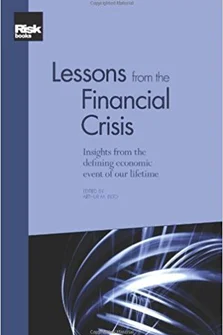Investment Strategy Returns: Volatility, Asymmetry, Fat Tails and the Nature of Alpha
Introduction to 'Lessons from the Financial Crisis'
The Credit Crunch of 2007: What Went Wrong? Why? What Lessons Can be Learned?
Underwriting versus Economy: A New Approach to Decomposing Mortgage Losses
The Shadow Banking System and Hyman Minsky’s Economic Journey
The Collapse of the Icelandic Banking System
The Quant Crunch Experience and the Future of Quantitative Investing
No Margin for Error: The Impact of the Credit Crisis on Derivatives Markets
The Re-Emergence of Distressed Exchanges in Corporate Restructurings
Modelling Systemic and Sovereign Risks
Measuring and Managing Risk in Innovative Financial Instruments
Forecasting Extreme Risk of Equity Portfolios with Fundamental Factors
Limits of Implied Credit Correlation Metrics Before and During the Crisis
Another view on the pricing of MBSs, CMOs and CDOs of ABS
Pricing of Credit Derivatives with and without Counterparty and Collateral Adjustments
A Practical Guide to Monte Carlo CVA
The Endogenous Dynamics of Markets: Price Impact, Feedback Loops and Instabilities
Market Panics: Correlation Dynamics, Dispersion and Tails
Financial Complexity and Systemic Stability in Trading Markets
The Martingale Theory of Bubbles: Implications for the Valuation of Derivatives and Detecting Bubbles
Managing through a Crisis: Practical Insights and Lessons Learned for Quantitatively Managed Equity Portfolios
Active Risk Management: A Credit Investor’s Perspective
Investment Strategy Returns: Volatility, Asymmetry, Fat Tails and the Nature of Alpha
The key question in investment management is to understand the sources of investment returns. Without such understanding, it is virtually impossible to succeed in managing money. Even risk management, usually a more scientific endeavour compared with the murky craft of predicting directional or relative movements of asset prices, becomes difficult if we have no proper framework within which to think about the future return distributions.
In this chapter, we explore the importance of non-Gaussian features of returns, such as time-varying volatility, asymmetry and fat tails. We demonstrate, using an empirical model of hedge fund strategy returns, that these non-Gaussian features significantly affect the expected returns. Moreover, we demonstrate that the volatility compensation is often a significant component of the expected returns of the investment strategies, suggesting that many of these strategies should be thought of as being “short vol”. The notable exceptions are the CTA strategies11 CTA funds are commonly known as “commodity trading advisors”, though the modern CTA investors often trade in futures of all asset classes, not just commodities. and certain fixed income and FX
Copyright Infopro Digital Limited. All rights reserved.
As outlined in our terms and conditions, https://www.infopro-digital.com/terms-and-conditions/subscriptions/ (point 2.4), printing is limited to a single copy.
If you would like to purchase additional rights please email info@risk.net
Copyright Infopro Digital Limited. All rights reserved.
You may share this content using our article tools. As outlined in our terms and conditions, https://www.infopro-digital.com/terms-and-conditions/subscriptions/ (clause 2.4), an Authorised User may only make one copy of the materials for their own personal use. You must also comply with the restrictions in clause 2.5.
If you would like to purchase additional rights please email info@risk.net










